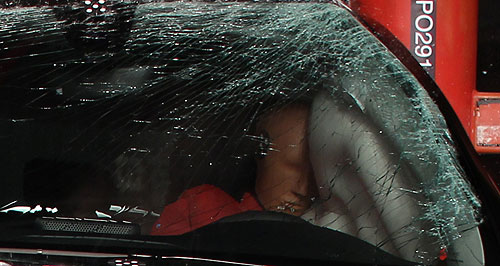Make / Model Search
News - General News - SafetyANCAP announces tighter tests for 2017Smashing news: ANCAP will make head-protecting front-side airbags mandatory for a lowly two-star rating from 2017. Amended roadmap focuses on making low-scoring cars safer as ANCAP tightens for 201720 Jun 2012 THE first annual update to Australasian crash safety authority ANCAP’s roadmap has been published, with the goalposts to be moved in 2017 as a way of ensuring higher levels of safety in relatively low-performing cars scoring one, two or three stars. In 2017 all-round three-point seatbelts and front seatbelt reminders will become mandatory across all star ratings and light commercial vehicles with a second row of fixed seats will require top-tether child seat anchoragesFront-side head-protecting airbags (such as the curtain variety) must be fitted to achieve a two-star rating, while ‘marginal’ roof strength, ‘acceptable’ pedestrian and whiplash protection plus the fitment of emergency brake assist will become the minimum for a three-star rating. Seatbelt reminders for rear seats, which become a five-star requirement in 2014, will be a prerequisite for a four-star rating in 2017. To more accurately determine which road map year a vehicle is to be assessed against, ANCAP has also refined its definition of what constitutes a new model, based on its compliance plate status and any running changes that have been made. The original ANCAP roadmap outlined the progressively more demanding minimum requirements for each star rating that would be applied for vehicles released between 2011 and 2016. While the minimum frontal offset, side impact and pole test scores remain unchanged from 2011 onwards, from this year ANCAP has started tightening the screws on pedestrian safety, whiplash protection and roof strength. From 2014 a five-star rating will require the minimum pedestrian safety rating to rise from ‘marginal’ to ‘acceptable’, whiplash prevention must jump from ‘acceptable’ to ‘good’ and in 2016 the minimum roof strength – tested from 2014 – must increase from ‘marginal’ to ‘acceptable’. Extra driver assistance technologies will become mandatory for a five-star rating from next year, starting with emergency brake assist, which becomes a four-star requirement from 2014 and a prerequisite for three stars in 2015. ANCAP will keep increasing the number of required driver assistance technologies each year, with additional airbags, blind-spot monitoring, lane-keeping assistance and fatigue detection among the qualifying systems. More basic technologies are also included, such as daytime running lights, all-round head restraints, hill-start assist, reversing cameras, speed limiters, tyre pressure monitoring and speedometers that show a maximum of 130km/h regardless of the vehicle’s capability. ANCAP chairman Lauchlan McIntosh described the roadmap as a “practical plan which will benefit manufacturers and consumers alike in reaching for higher levels of vehicle safety”. “The development of vehicle safety systems is moving forward at a rapid pace and ANCAP is moving just as fast by ensuring manufacturers continue to include, and progressively increase these life-saving technologies into their builds.”  Read more17th of May 2012  Mercedes-Benz B-Class tops ANCAP ratingsAlmost perfect score for Mercedes B-Class as it achieves highest ANCAP score to date2nd of April 2012  Market Insight: Five ANCAP stars now the normCars, SUVs getting safer as ANCAP influence grows, but commercials still lagging |
Click to shareGeneral News articlesResearch General News Motor industry news |











Facebook Twitter Instagram